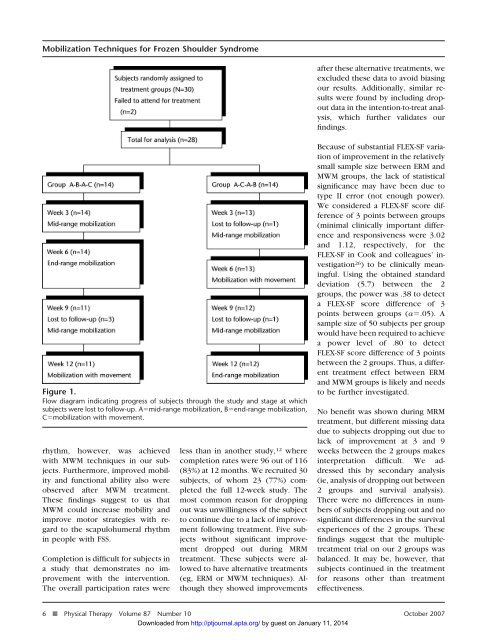Mobilization Techniques in Subjects With Frozen Shoulder ...
Mobilization Techniques in Subjects With Frozen Shoulder ...
Mobilization Techniques in Subjects With Frozen Shoulder ...
You also want an ePaper? Increase the reach of your titles
YUMPU automatically turns print PDFs into web optimized ePapers that Google loves.
<strong>Mobilization</strong> <strong>Techniques</strong> for <strong>Frozen</strong> <strong>Shoulder</strong> Syndrome<br />
after these alternative treatments, we<br />
excluded these data to avoid bias<strong>in</strong>g<br />
our results. Additionally, similar results<br />
were found by <strong>in</strong>clud<strong>in</strong>g dropout<br />
data <strong>in</strong> the <strong>in</strong>tention-to-treat analysis,<br />
which further validates our<br />
f<strong>in</strong>d<strong>in</strong>gs.<br />
Figure 1.<br />
Flow diagram <strong>in</strong>dicat<strong>in</strong>g progress of subjects through the study and stage at which<br />
subjects were lost to follow-up. Amid-range mobilization, Bend-range mobilization,<br />
Cmobilization with movement.<br />
rhythm, however, was achieved<br />
with MWM techniques <strong>in</strong> our subjects.<br />
Furthermore, improved mobility<br />
and functional ability also were<br />
observed after MWM treatment.<br />
These f<strong>in</strong>d<strong>in</strong>gs suggest to us that<br />
MWM could <strong>in</strong>crease mobility and<br />
improve motor strategies with regard<br />
to the scapulohumeral rhythm<br />
<strong>in</strong> people with FSS.<br />
Completion is difficult for subjects <strong>in</strong><br />
a study that demonstrates no improvement<br />
with the <strong>in</strong>tervention.<br />
The overall participation rates were<br />
less than <strong>in</strong> another study, 12 where<br />
completion rates were 96 out of 116<br />
(83%) at 12 months. We recruited 30<br />
subjects, of whom 23 (77%) completed<br />
the full 12-week study. The<br />
most common reason for dropp<strong>in</strong>g<br />
out was unwill<strong>in</strong>gness of the subject<br />
to cont<strong>in</strong>ue due to a lack of improvement<br />
follow<strong>in</strong>g treatment. Five subjects<br />
without significant improvement<br />
dropped out dur<strong>in</strong>g MRM<br />
treatment. These subjects were allowed<br />
to have alternative treatments<br />
(eg, ERM or MWM techniques). Although<br />
they showed improvements<br />
Because of substantial FLEX-SF variation<br />
of improvement <strong>in</strong> the relatively<br />
small sample size between ERM and<br />
MWM groups, the lack of statistical<br />
significance may have been due to<br />
type II error (not enough power).<br />
We considered a FLEX-SF score difference<br />
of 3 po<strong>in</strong>ts between groups<br />
(m<strong>in</strong>imal cl<strong>in</strong>ically important difference<br />
and responsiveness were 3.02<br />
and 1.12, respectively, for the<br />
FLEX-SF <strong>in</strong> Cook and colleagues’ <strong>in</strong>vestigation<br />
26 ) to be cl<strong>in</strong>ically mean<strong>in</strong>gful.<br />
Us<strong>in</strong>g the obta<strong>in</strong>ed standard<br />
deviation (5.7) between the 2<br />
groups, the power was .38 to detect<br />
a FLEX-SF score difference of 3<br />
po<strong>in</strong>ts between groups (.05). A<br />
sample size of 50 subjects per group<br />
would have been required to achieve<br />
a power level of .80 to detect<br />
FLEX-SF score difference of 3 po<strong>in</strong>ts<br />
between the 2 groups. Thus, a different<br />
treatment effect between ERM<br />
and MWM groups is likely and needs<br />
to be further <strong>in</strong>vestigated.<br />
No benefit was shown dur<strong>in</strong>g MRM<br />
treatment, but different miss<strong>in</strong>g data<br />
due to subjects dropp<strong>in</strong>g out due to<br />
lack of improvement at 3 and 9<br />
weeks between the 2 groups makes<br />
<strong>in</strong>terpretation difficult. We addressed<br />
this by secondary analysis<br />
(ie, analysis of dropp<strong>in</strong>g out between<br />
2 groups and survival analysis).<br />
There were no differences <strong>in</strong> numbers<br />
of subjects dropp<strong>in</strong>g out and no<br />
significant differences <strong>in</strong> the survival<br />
experiences of the 2 groups. These<br />
f<strong>in</strong>d<strong>in</strong>gs suggest that the multipletreatment<br />
trial on our 2 groups was<br />
balanced. It may be, however, that<br />
subjects cont<strong>in</strong>ued <strong>in</strong> the treatment<br />
for reasons other than treatment<br />
effectiveness.<br />
6 f Physical Therapy Volume 87 Number 10 October 2007<br />
Downloaded from http://ptjournal.apta.org/ by guest on January 11, 2014
















